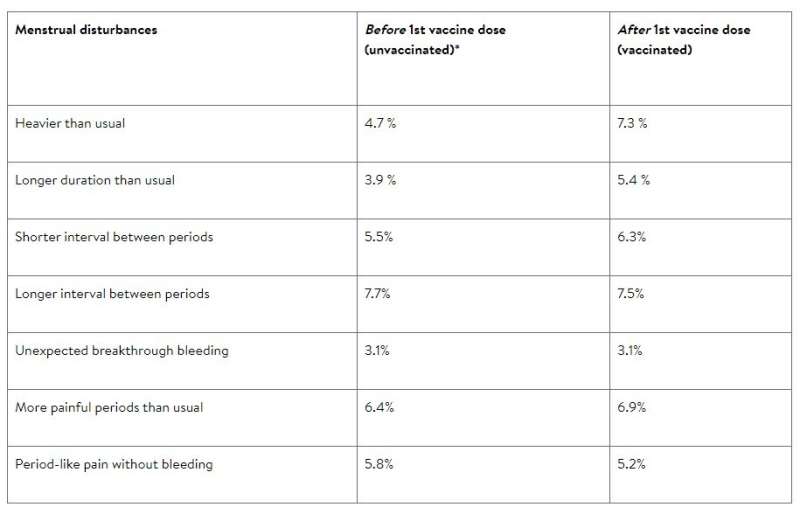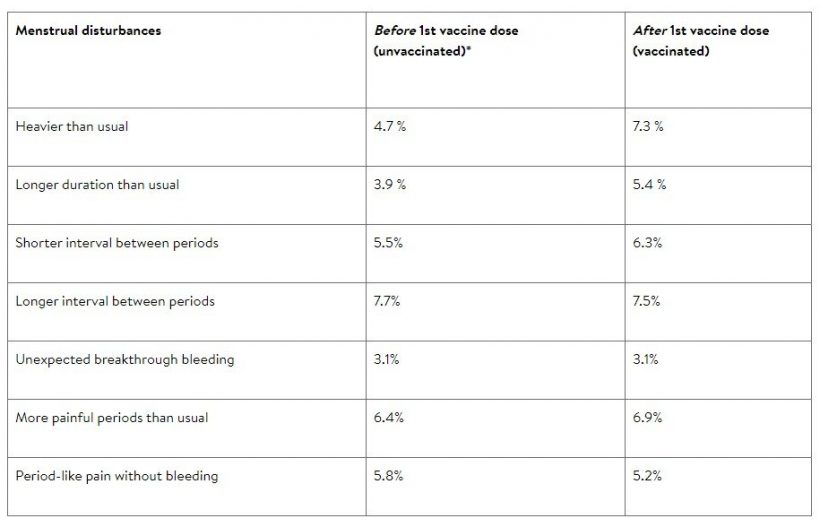
The first reports that several women experienced menstrual disturbances after coronavirus vaccination came early in summer 2021. The Norwegian Institute of Public Health (NIPH) promptly introduced questions about menstrual disturbances into ongoing population studies. The first results indicated that coronavirus vaccination can affect menstruation in women between the ages of 18 and 30.
A new study from the NIPH published in Vaccine also shows an increased incidence in girls between 12-15 years of age.
“4.7 percent of the participants reported that their last period before vaccination was heavier than they usually experience. After vaccination, 7.3 percent reported that the first period after the vaccine was heavier than usual,” says Dr. Lill Trogstad, project manager.
“The same pattern was seen for longer duration of menstruation, shorter interval between menstrual cycles and for worse period pain than usual,” she adds.
Results
- Around 80 percent of girls in this age group received one vaccine dose. Almost all the girls in the study had received Comirnaty (BioNTech and Pfizer).
- The study shows that menstrual disturbances among girls aged 12–15 are common. 22.6 percent of the girls in the study had experienced disturbances during their last period before
- The proportion who experienced heavier menstrual bleeding than usual was higher after vaccination (7.3 percent) than before vaccination (4.7 percent).
- Only 1.5 percent of the vaccinated girls had had a COVID-19 infection during the time when the study was carried out. Among the girls who were not vaccinated, 28 percent had had a COVID-19 infection.
- We saw an indication that unvaccinated girls who had COVID-19 infection also had an increased incidence of menstrual disturbances, but the association with infection should be followed up by further studies.
Over 7,000 MoBa mothers participated in the study
Mothers in the Norwegian Mother, Father and Child Study (MoBa) were asked whether their daughters had experienced menstrual disturbances before and/or after the first dose of the coronavirus vaccine. The results are based on questions that 7,565 MoBa mothers answered on behalf of their children between 11-15 October 2021. At that time, adolescents aged 12–15 who had not had COVID-19 infection were recommended to be vaccinated with one dose of Comirnaty (BioNTech and Pfizer).
The main purpose of this study was to find out whether menstrual disturbances occur more frequently among vaccinated than non-vaccinated girls.
This is the first study to look at menstrual disturbances in this age group. The findings should be confirmed in further studies.
The events studied were:
- unusually heavy menstrual bleeding
- unusually prolonged periods
- unusually short interval between periods
- unusually long interval between periods
- unexpected breakthrough bleeding
- unusually painful periods
- period-like pain without bleeding
The questions used to clarify this were:
- Did she experience any of the following during her last period before vaccination?
- Did she experience any of the following during her first period after vaccination?
Higher risk after vaccination
There was no difference before and after vaccination in the incidence of prolonged intervals between menstrual cycles, breakthrough bleeding or period pain/cramps without bleeding after the first dose.
The results did not change when the girls who had previously had COVID-19 infection were excluded from the analyses. The study does not provide information on the duration of the menstrual disturbances.
We found a higher risk of experiencing heavier menstrual bleeding than usual after vaccination with one dose, with a relative risk (RR) of 1.60 (95 percent confidence interval 1.43-1.80). A higher risk of longer duration of bleeding was also seen, with a relative risk of 1.39 (95 percent confidence interval 1.22-1.59).

Limitations in the study
The answers in this study are based on the mothers’ report of menstrual disturbances in their daughters.
There has been a lot of media attention around the signals about menstrual disturbances after coronavirus vaccination, and this may also contribute to awareness among more mothers and/or girls reporting menstrual disturbances after vaccination, even though they may have previously experienced the same without vaccination.
Studies initiated at NIPH after reports of menstrual disturbances
The Norwegian Medicines Agency publishes regular updates of side effect reports after coronavirus vaccination: Side effect reports for coronavirus vaccines.
Early in summer 2021, the first reports came that several women experienced menstrual disturbances which they attributed to vaccination. To investigate any connection between coronavirus vaccination and menstrual disturbances, the NIPH began a large study among more than 60,000 women aged 12–80 in Norway. Using electronic questionnaires, the participants answered questions about menstruation and menstrual disturbances.
Follow-up and data analyses continue both in MoBa and in the other study cohorts. This will be able to provide answers about menstrual disturbances and bleeding in other age groups, and about the duration of the problems. Data from the studies also showed an increased incidence of menstrual disturbances in young women aged 18-30 after vaccination against coronavirus
More information:
Ida Henriette Caspersen et al, Menstrual disturbances in 12- to 15-year-old girls after one dose of COVID-19 Comirnaty vaccine: Population-based cohort study in Norway, Vaccine (2022). DOI: 10.1016/j.vaccine.2022.11.068
Lill Trogstad, Increased Occurrence of Menstrual Disturbances in 18- to 30-Year-Old Women after COVID-19 Vaccination, SSRN Electronic Journal (2022). DOI: 10.2139/ssrn.3998180
Journal information:
Vaccine
Source: Read Full Article
